Literary method, style, or literary movement are often treated as synonyms. It is based on a similar type of artistic thinking in different writers. Sometimes contemporary author does not realize in which direction he works, and evaluates it creative method literary scholar or critic. And it turns out that the author is a sentimentalist or an acmeist ... We present to your attention the literary trends in the table from classicism to modernity.
There were cases in the history of literature when representatives of the writing fraternity themselves realized theoretical basis their activities, promoted them in manifestos, united in creative groups. For example, the Russian futurists, who appeared in the press with the manifesto "Slap in the face of public taste."
Today we are talking about the current system literary trends past, which determined the features of the development of the world literary process, and studied by the theory of literature. The main literary trends are:
- classicism
- sentimentalism
- romanticism
- realism
- modernism (divided into currents: symbolism, acmeism, futurism, imagism)
- social realism
- postmodernism
Modernity is most often associated with the concept of postmodernism, and sometimes socially active realism.
Literary trends in tables
| Classicism | Sentimentalism | Romanticism | Realism | Modernism | |
|---|---|---|---|---|---|
periodization |
literary direction XVII – early XIX centuries, based on imitation of antique samples. | Literary direction of the second half of XVIII- the beginning of the 19th century. From French word"Sentiment" - feeling, sensitivity. | literary direction late XVIII- second half of XIX in. Romanticism arose in the 1790s. first in Germany and then spread throughout the Western European cultural region Greatest development received in England, Germany, France (J. Byron, W. Scott, V. Hugo, P. Merimee) | trend in literature and art XIX century, which aims to faithfully reproduce reality in its typical features. | literary movement, aesthetic concept that was formed in the 1910s. The founders of modernism: M. Proust "In Search of Lost Time", J. Joyce "Ulysses", F. Kafka "The Process". |
Signs, features |
|
Special attention- to peace of mind person. The main thing is the feeling, the experience common man not great ideas. Characteristic genres - elegy, epistle, novel in letters, diary, in which confessional motives prevail | Heroes are bright exceptional personalities in unusual circumstances. Romanticism is characterized by an impulse, an extraordinary complexity, inner depth human individuality. For romantic work the idea of two worlds is characteristic: the world in which the hero lives, and another world in which he wants to be. | Reality is a means of man's knowledge of himself and the world around him. Typification of images. This is achieved through the veracity of details in specific conditions. Even in a tragic conflict, art is life-affirming. Realism is inherent in the desire to consider reality in development, the ability to detect the development of new social, psychological and social relations. | The main task of modernism is to penetrate into the depths of consciousness and subconsciousness of a person, to transfer the work of memory, the peculiarities of perception of the environment, in how the past, present and the future are refracted in “instant moments of being”. The main technique in the work of modernists is the "stream of consciousness", which allows you to capture the movement of thoughts, impressions, feelings. |
Features of development in Russia |
An example is Fonvizin's comedy "Undergrowth". In this comedy, Fonvizin tries to realize main idea classicism - to re-educate the world with a reasonable word. | An example is the story of N.M. Karamzin " Poor Lisa", which, in contrast to rational classicism with its cult of reason, affirms the cult of feelings, sensuality. | In Russia, romanticism was born against the backdrop of a national upsurge after the war of 1812. It has a pronounced social orientation. He is imbued with the idea of civic service and love of freedom (K. F. Ryleev, V. A. Zhukovsky). | In Russia, the foundations of realism were laid in the 1820s and 1830s. Pushkin's work ("Eugene Onegin", "Boris Godunov" Captain's daughter", late lyrics). this stage is associated with the names of I. A. Goncharov, I. S. Turgenev, N. A. Nekrasov, A. N. Ostrovsky and others. critical. | In Russian literary criticism, it is customary to call modernist 3 literary movements that declared themselves in the period from 1890 to 1917. These are symbolism, acmeism and futurism, which formed the basis of modernism as a literary movement. |
Modernism is represented by the following literary movements:
Symbolism
(Symbol - from the Greek. Symbolon - a conventional sign)
- The central place is given to the symbol *
- The striving for the highest ideal prevails
- The poetic image is intended to express the essence of a phenomenon.
- Characteristic reflection of the world in two plans: real and mystical
- Elegance and musicality of the verse
Acmeism
(From the Greek "acme" - a point, the highest point).
The literary current of acmeism arose in the early 1910s and was genetically associated with symbolism. (N. Gumilyov, A. Akhmatova, S. Gorodetsky, O. Mandelstam, M. Zenkevich and V. Narbut.) M. Kuzmin's article "On Fine Clarity", published in 1910, had an influence on the formation. AT policy article 1913 "The legacy of acmeism and symbolism" N. Gumilyov called symbolism "a worthy father", but emphasized at the same time that the new generation had developed a "courageously firm and clear outlook on life"
- Focus on classical poetry 19th century
- Adoption earthly world in its diversity, visible concreteness
- Objectivity and clarity of images, sharpness of details
- In rhythm, acmeists used dolnik (Dolnik is a violation of the traditional regular alternation of stressed and unstressed syllables. The lines coincide in the number of stresses, but the stressed and unstressed syllables are freely located in the line.), which brought the poem closer to the living colloquial speech
Futurism
Futurism - from lat. futurum, the future.
Genetically, literary futurism is closely connected with the avant-garde groupings of artists of the 1910s - primarily with the groups Jack of Diamonds, Donkey's Tail, and the Union of Youth. In 1909, in Italy, the poet F. Marinetti published the article "Manifesto of Futurism." In 1912, the manifesto “Slapping the Face of Public Taste” was created by Russian futurists: V. Mayakovsky, A. Kruchenykh, V. Khlebnikov: “Pushkin is more incomprehensible than hieroglyphs.” Futurism began to disintegrate already in 1915-1916.
- Rebelliousness, anarchic worldview
- Rejection of cultural traditions
- Experiments in the field of rhythm and rhyme, figured arrangement of stanzas and lines
- Active word creation
Imagism
From lat. imago - image A literary trend in Russian poetry of the 20th century, whose representatives stated that the purpose of creativity was to create an image. Main means of expression Imagists - a metaphor, often metaphorical chains, juxtaposing various elements two images - direct and figurative. Imagism arose in 1918, when the "Order of Imagists" was founded in Moscow. The creators of the "Order" were Anatoly Mariengof, Vadim Shershenevich and Sergei Yesenin, who was previously a member of the group of new peasant poets
Part 1
11 "A" class
Teacher: Sheshukova L.A.
Subject: Introduction. Characteristics of the literary process at the beginning of the 20th century. Variety of literary trends, styles, schools, groups.
Goals: to give an idea of the connection between the historical and literary processes of the beginning of the 20th century; find out what is the originality of realism in Russian literature of the beginning of the century; note the diversity of literary trends, styles, schools, groups.
During the classes.
Time is the most interesting
by the variegation of its contradictions
and their abundance.
M. Gorky
Lecture. (the course of the lecture is outlined by the students).
1. Socio-economic and political development Russia.
The beginning of the 20th century is the reign of Emperor Nicholas II, who ascended the throne in 1894. Russia at that time was a country with an average level of development of capitalism. The abolition of serfdom in 1861, the reforms of the 60s and 70s did not go unnoticed: capitalist industry grew rapidly(first place in the world), new industries (oil, chemical, mechanical engineering) and new industrial regions (primarily Donbass-Krivoy Rog) arose.
Railways connected the Center with the outskirts and stimulated the development of the country.
arose big banks industry related.
Financial system after the one held in 1897 by the Minister of Finance S.Yu. Witte's reforms (the introduction of the gold backing of the ruble and the free exchange of paper money for gold) was one of the most stable in the world.
Russia entered the top five most developed industrial countries.
But high quantitative indicators (growth rates, concentration level, production volumes) were combined with rather low qualitative ones. Labor productivity was low. The development of the economy was extremely uneven across sectors and regions of the country.
The agrarian question acquired extreme acuteness at the beginning of the 20th century. Historians call Agriculture Achilles' heel of contemporary Russia.
Economic modernization has begun to have some effect on social structure countries. The nobility (1% of the population) remained a privileged, politically dominant class, but its economic situation gradually worsened.
impoverishment noble estates, described with sympathy by I.A. Bunin and A.P. Chekhov, was a remarkable phenomenon of the era.
The bourgeoisie, which was acquiring a serious economic importance, was not single. A new Petersburg bourgeoisie grew up, closely connected with the state, banks and advanced industries.
The peasantry (more than 80% of the population) suffered from lack of land.
The position of the working class (less than 10% of the population) at the beginning of the 20th century was difficult. Long working day, bad living conditions, low wage, lack of rights - these are the reasons that caused the discontent of the workers.
Special social groups were the bureaucracy, the clergy and the intelligentsia.
By the beginning of the 20th century, modernization had practically not affected political sphere. Russia remained an autocratic (absolute) monarchy.
2 . Culture in Russia at the beginning of the 20th century.
Entering the 20th century, Russia was changing. Freedom of speech, press, assembly, activity became a reality political parties. The revolution of 19050-1907 was a shock and a warning to society and the authorities.
There is nothing surprising in the fact that the beginning of the century brought Russia an extraordinary flowering of culture - heroic and tragic at the same time.
Significant changes took place in the education system. The task of eradicating illiteracy, the introduction of universal primary education. The periodical press and book publishing played an important educational role.
The discoveries of Russian scientists had global importance. Laureates Nobel Prize became I. Pavlov and I. Mechnikov.
AT artistic culture the beginning of the 20th century - a violent development of styles, trends, ideas, methods. The golden age of Russian culture, experienced in the 19th century, is replaced by its silver age, a new and whimsical dawn.
The reading public is engrossed romantic stories M. Gorky and was shocked by his play "At the Bottom". Popular I. Kuprin ("Duel", " Garnet bracelet”) and L. Andreev (“The Life of a Man”, “Tsar-Hunger”), I. Bunin is sad about the fate of the noble estates.
And in poetry, symbolist decadents (A. Blok, K. Balmont, V. Bryusov), acmeists (N. Gumilyov, A. Akhmatova), futurists (V. Mayakovsky, V. Khlebnikov) triumph. They criticize realism for sociality, naturalism, slavish adherence to reality and the desire to display it without transforming it.
Something similar happens in painting. They revere the realists I. Repin, V. Surikov, the Vasnetsov brothers, but willingly visit the seemingly scandalous exhibitions of the World of Art (A. Benois, K. Korovin) and the Jack of Diamonds (P. Konchalovsky, R. Falk).
N. Rimsky-Korsakov continues to work in music (the operas The Tale of Tsar Saltan, The Golden Cockerel), who taught A. Glazunov and I. Stravinsky (the ballet Petrushka). New artistic discoveries for Russia are the music of the young S. Rachmaninov and experimental opuses by A. Scriabin.
The Russian realistic theater is flourishing. The system of K. Stanislavsky, who together with V. Nemirovich-Danchenko created the Moscow Art Theater, receives worldwide fame. The great theatrical reformers V. Meyerhold and E. Vakhtangov also come to the stage. Singer F. Chaliapin, ballet dancer A. Pavlova shine, Vera Kholodnaya and Ivan Mozzhukhin star in the first silent films.
The famous Russian Seasons (since 1907) are held in Paris, exhibitions of Russian painting, music and ballet are offered to sophisticated Parisians. Delight causes "The Dying Swan" performed by Anna Pavlova.
In culture - silver Age.
3. The Silver Age of Russian Literature.
1) In parallel with the emergence of more and more new poetic schools, one of the most interesting trends of the era was growing stronger - the growth of the personal principle, the raising of the status of creative individuality in art.
Poets “are different from each other, from different clays. After all, these are all Russian poets, not for yesterday, not for today, but forever. God didn't hurt us like that." (O. Mandelstam).
2) Literary school (trend) and creative individuality are two key categories of the literary process of the early 20th century. Aesthetic mind- The general trend in the lyrics of the Silver Age.
Characteristic figures standing outside the directions ("Lone Stars") were M. Tsvetaeva, M. Kuzmin, V, Khodasevich.
3) The development of capitalist relations leads to the emergence of the theme modern city(“The Factory” by A. Blok, “Twilight” by V. Bryusov, “Tosca of the Station” by I. Annensky, etc.).
4) the desire to express more complex, volatile or contradictory states of the soul required a new attitude to the word-image:
I am a sudden break
I am the playing thunder
I am a clear stream
I am for everyone and no one.
K. Balmont.
There was a premonition of "coming rebellions":
Where are you, future Huns,
What cloud hung over the world?
I hear your cast-iron clatter
Through the still undiscovered Pamirs.
V. Bryusov.
5) The poems include exotic images and motifs as a counteraction to the measured bourgeois life (“Giraffe”, “Lake Chad” by N. Gumilyov).
6) Futurist poets proclaim a resolute "no" to the legacy of the classics, destroying the "aesthetics of junk" (verses by V. Mayakovsky, V. Khlebnikov, etc.).
part 1
Time is most interesting by the diversity of its contradictions and their abundance. M. Gorky
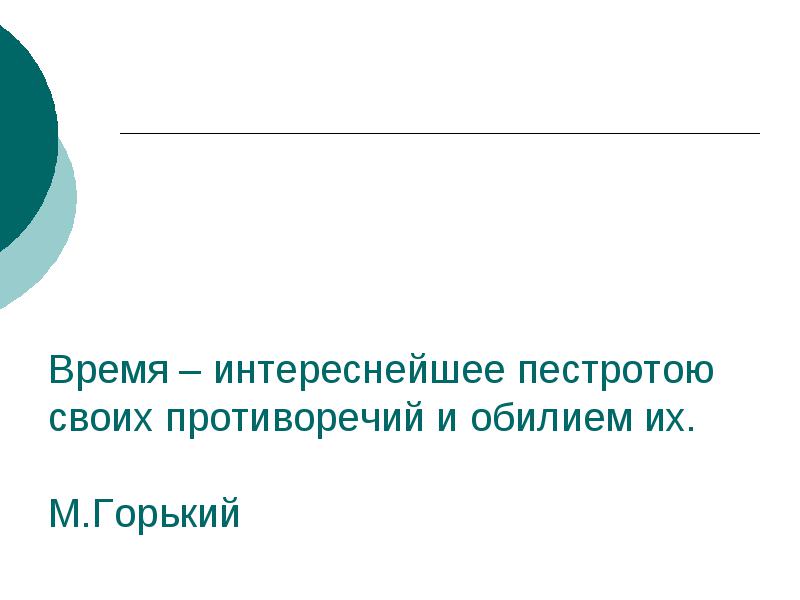

At the turn of the 19th and 20th centuries, Russia experienced changes in all areas of life. This milestone is characterized by extreme tension, the tragedy of time. The date of transition from century to century acted magically. Feelings of uncertainty, instability, decline, the end of history prevailed in public sentiment.
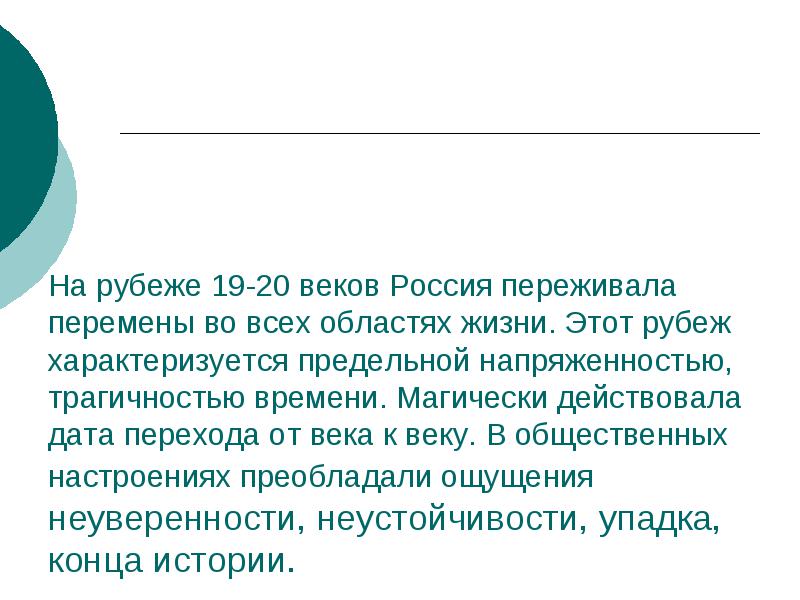
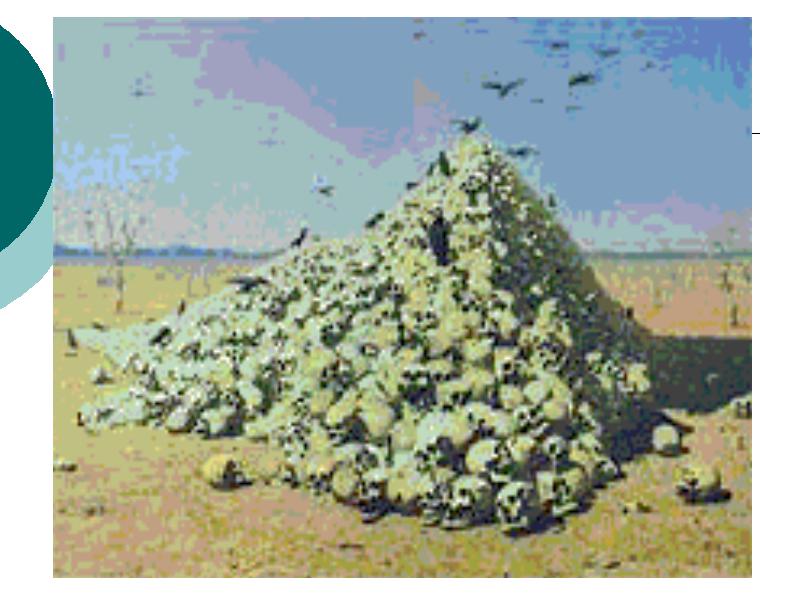
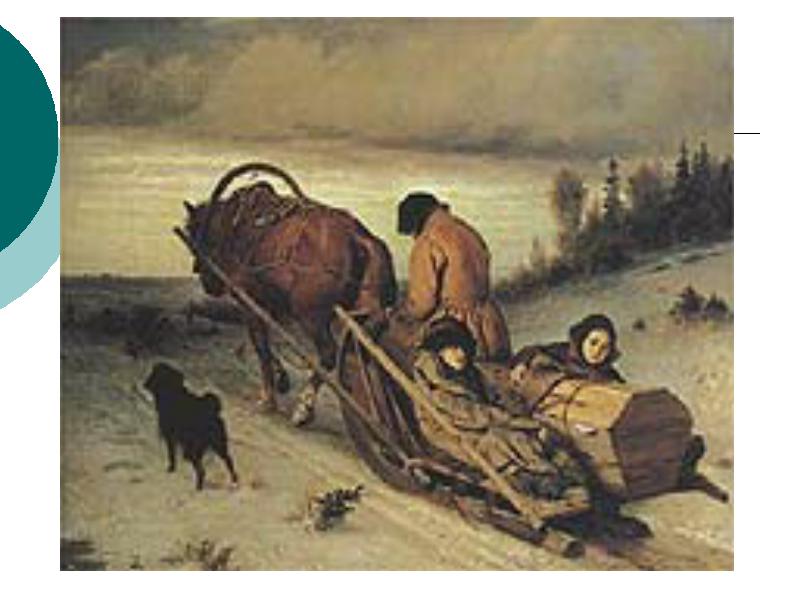

A new era has arrived in literature. New problems, new topics, new authors
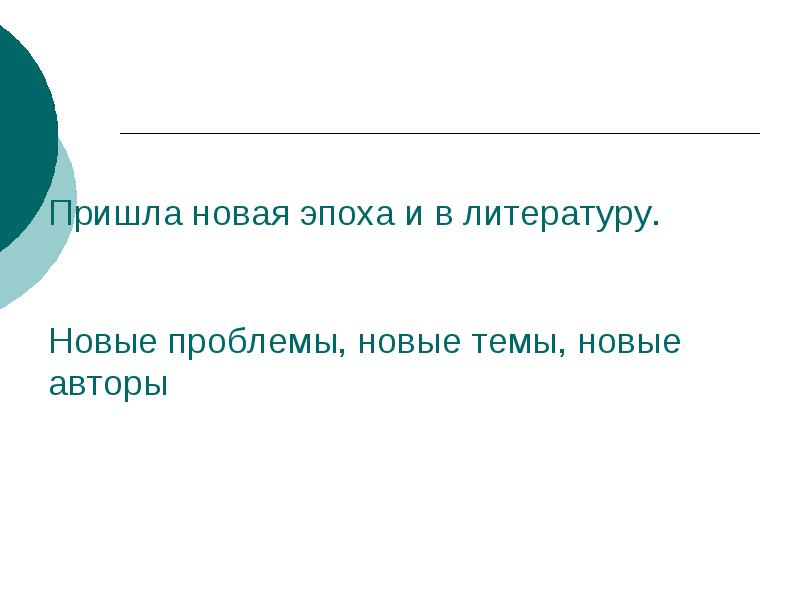
A.A. Blok
TWO WORLDS
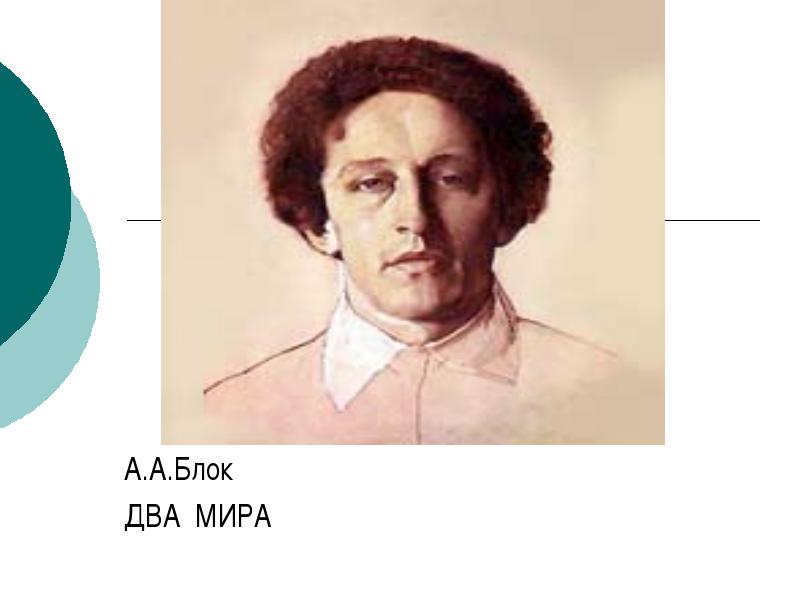
“Unheard-of changes, unprecedented rebellions…” - thus, in the words of A. Blok, one can characterize the atmosphere of the turn of the 19th and 20th centuries. In what way did this manifest itself?
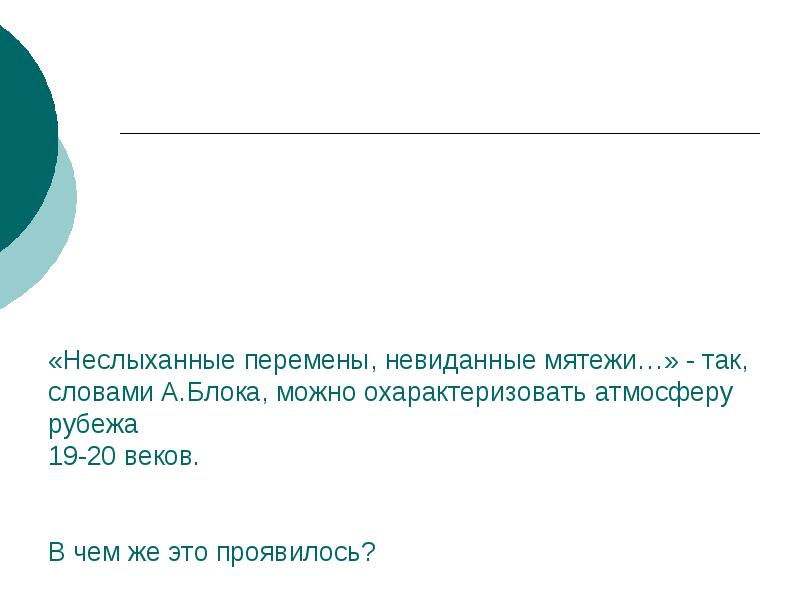
Socio-economic and political development of Russia
The beginning of the 20th century - the reign of Emperor Nicholas II
Russia is a country with an average level of development of capitalism
Railways connected the Center with the outskirts
Large banks emerged
The ruble has become one of the most stable currencies in the world
Russia entered the top five most developed industrial countries
But at the same time, low productivity
backward agriculture

The impoverishment of noble estates is a remarkable phenomenon of the era (I.A. Bunin "Antonov apples" and A.P. Chekhov "The Cherry Orchard")
The peasantry (more than 80% of the population) suffers from lack of land
The plight of the working class - low wages,
lack of rights, long working hours, poor living conditions
Officials, clergy, intelligentsia - special social groups
Russia remained an autocratic (absolute) monarchy
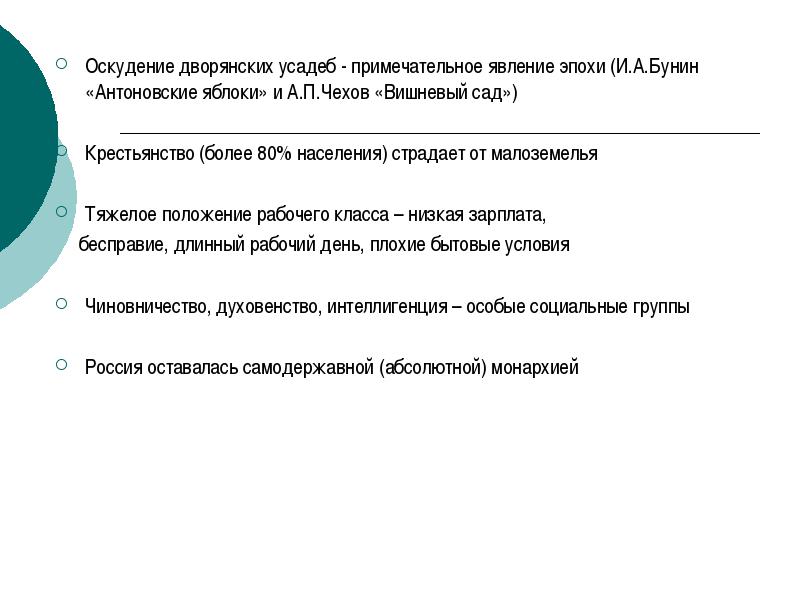
Culture of Russia at the beginning of the 20th century
Changes in the education system - the elimination of illiteracy, the introduction of universal primary education
Development of periodicals and book publishing
Discoveries of Russian scientists in the field of medicine: I. Pavlov and I. Mechnikov became Nobel Prize winners
In artistic culture - a variety of styles, trends, ideas, methods
The "golden" age of Russian culture, experienced in the 19th century, is replaced by the "Silver" age, new and whimsical
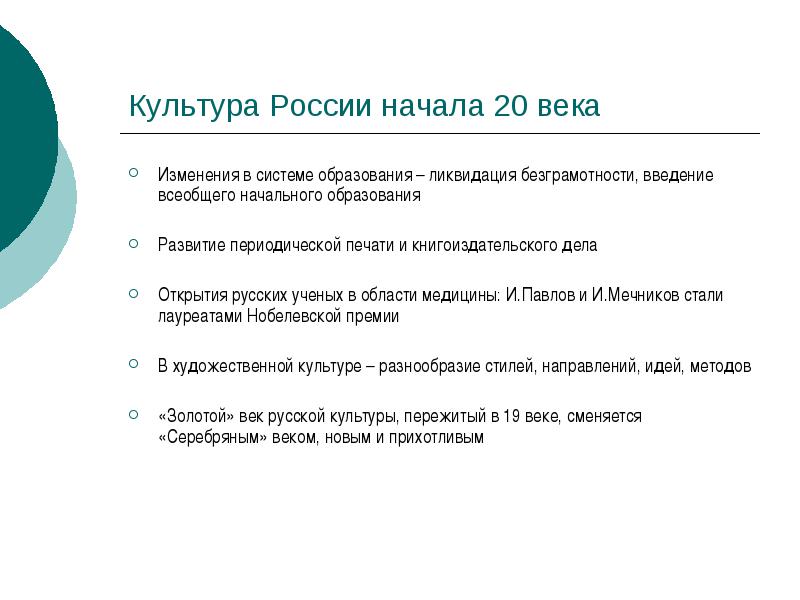
The voice of the luminary of Russian realistic literature L.N. Tolstoy still sounds

The latest plays by A.P. Chekhov "The Seagull", "The Cherry Orchard", "Uncle Vanya" are discussed
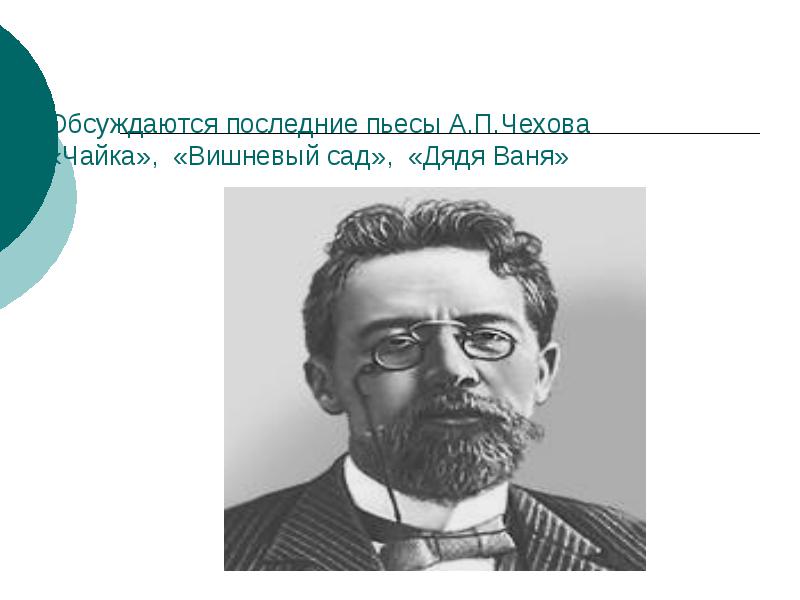
The reading public is fascinated by the romantic stories of M. Gorky and shocked by his play "At the Bottom"
"At the bottom" - the first work of M. Gorky, which brought world fame to the author
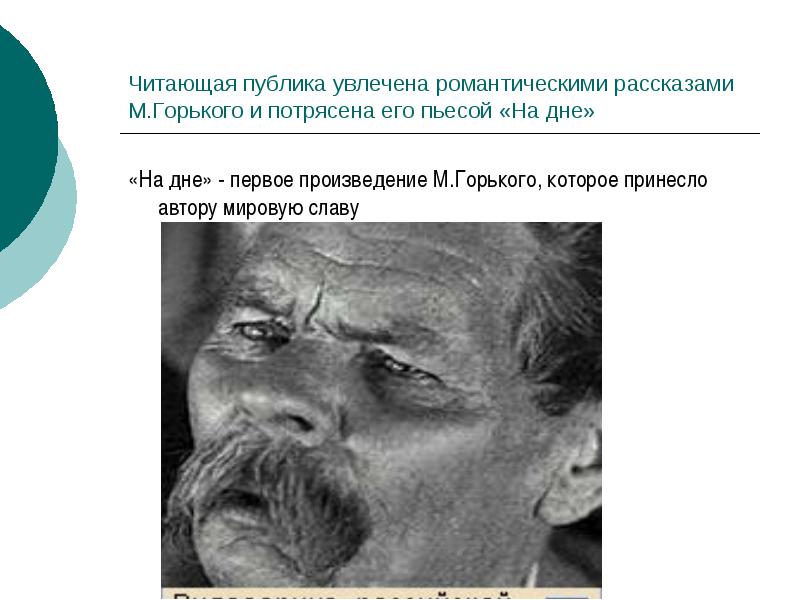
Popular A.I. Kuprin and his wonderful stories about love "Olesya", "Garnet Bracelet", "Shulamith"
True love is the basis of everything earthly.
This feeling should not be either frivolous or primitive, it should not be based on profit and self-interest.
Love should be based on lofty feelings, on mutual respect, sympathy, trust, fidelity, sincerity.
Such love must be carried in oneself all one's life, not exchanging for petty passions and hobbies.
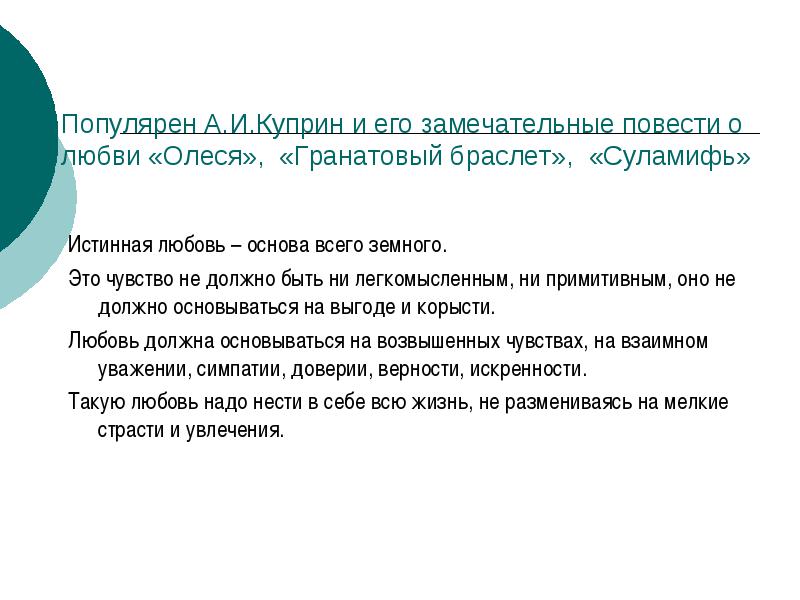
The rarest gift of high love is great happiness. Missing it is a crime.
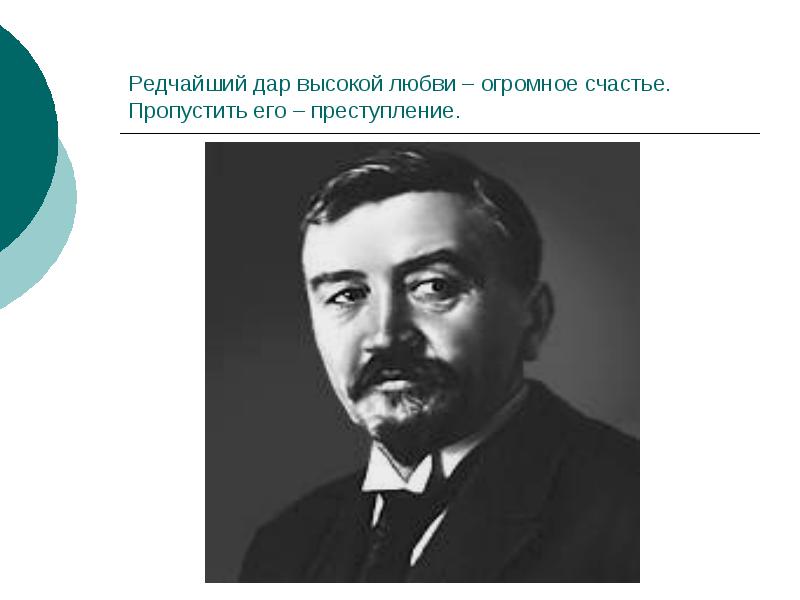
Sad about the fate of the noble estates I.A. Bunin in the story "Antonov apples". In a philosophical story "Easy breath" Bunin reveals his religious idea of the world, of man, of the soul.

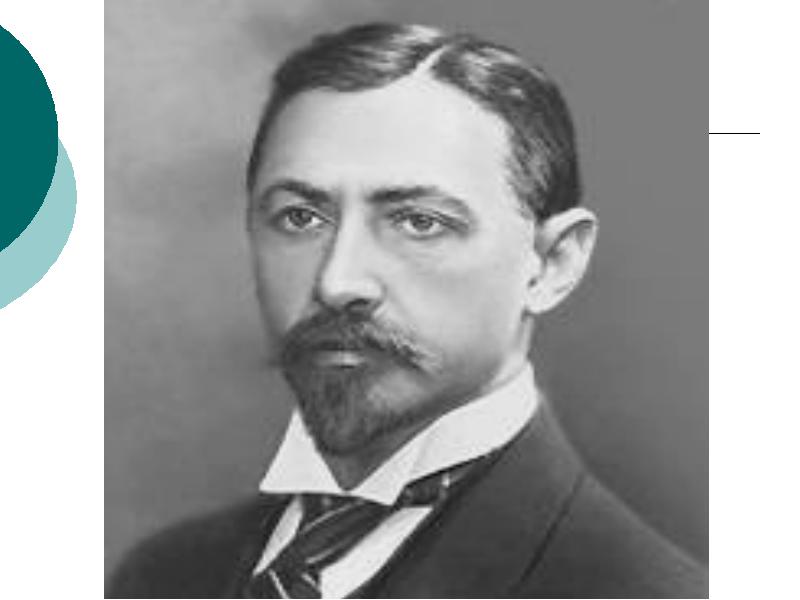
Decadents-symbolists triumph in poetry A. Blok, K. Balmont, V. Bryusov
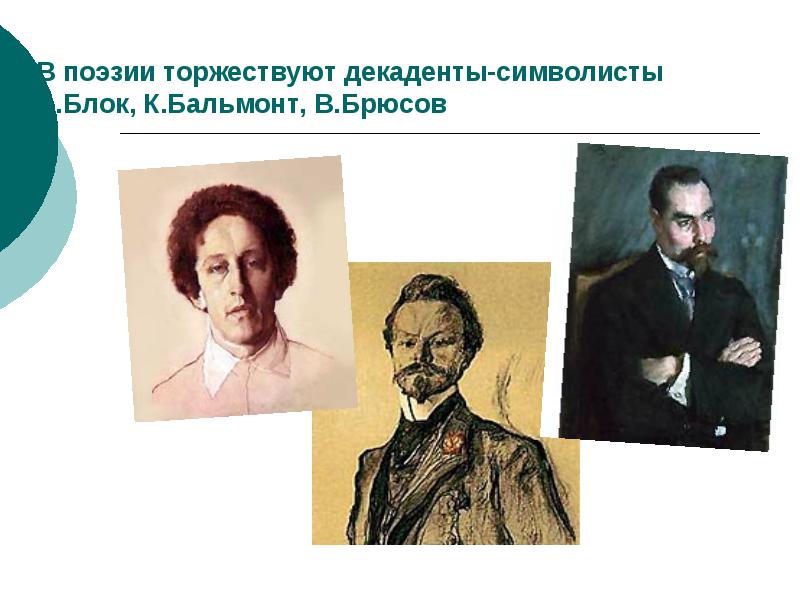
Acmeists N. Gumilyov and A. Akhmatova, futurists V. Mayakovsky and V. Khlebnikov criticize realism for sociality, naturalism, slavish adherence to reality and the desire to display it without transforming
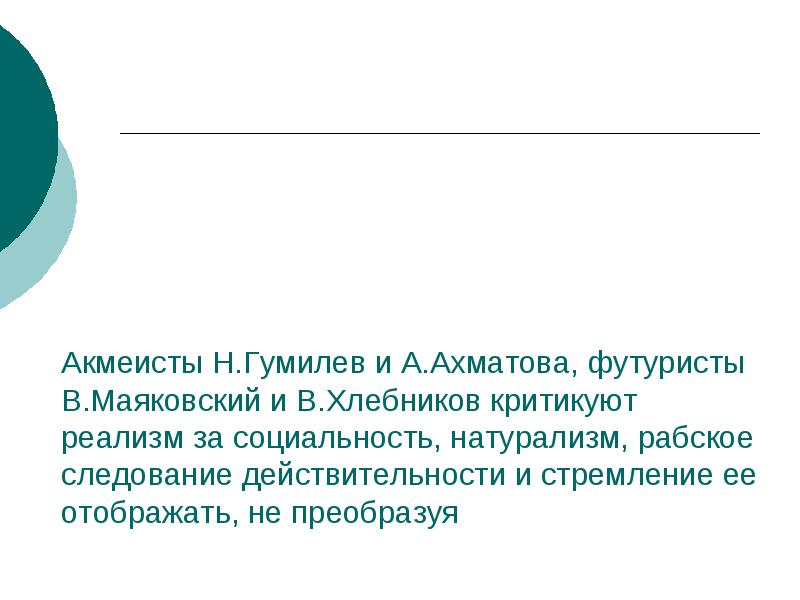
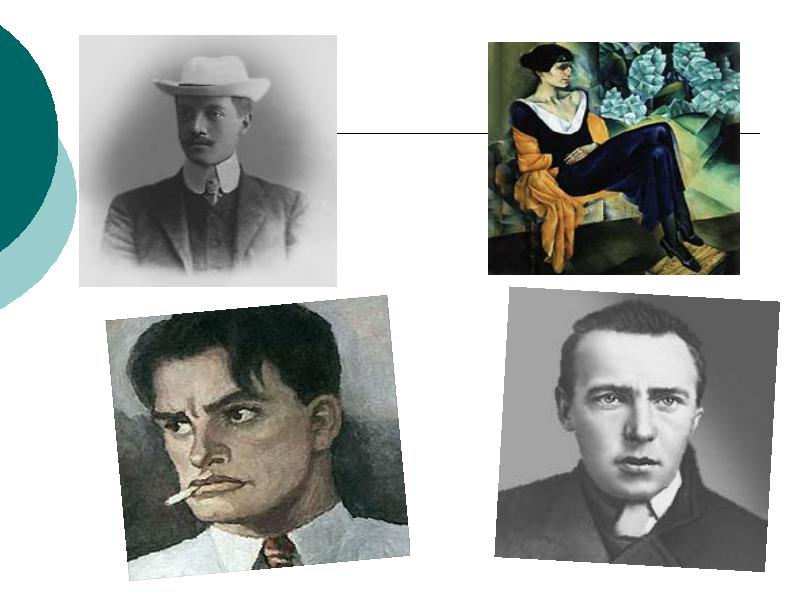
In painting, the realists I. Repin, V. Surikov, the Vasnetsov brothers are revered
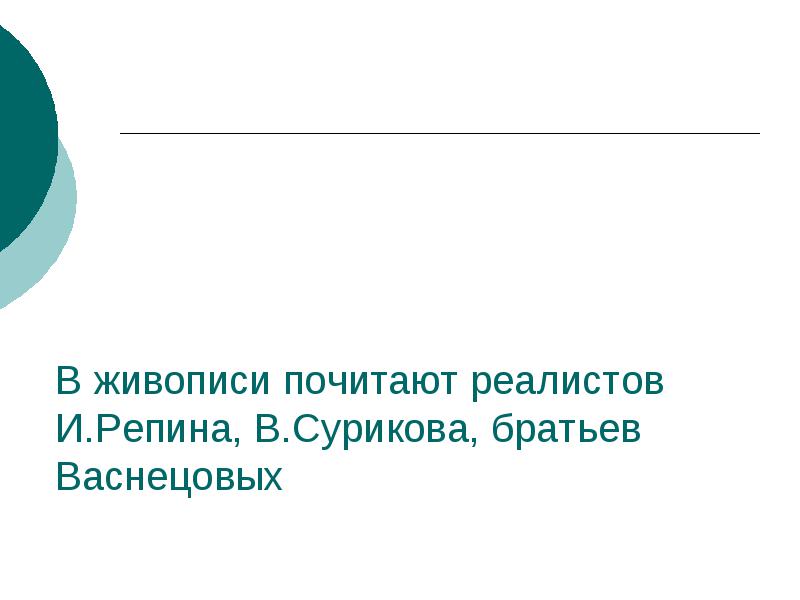
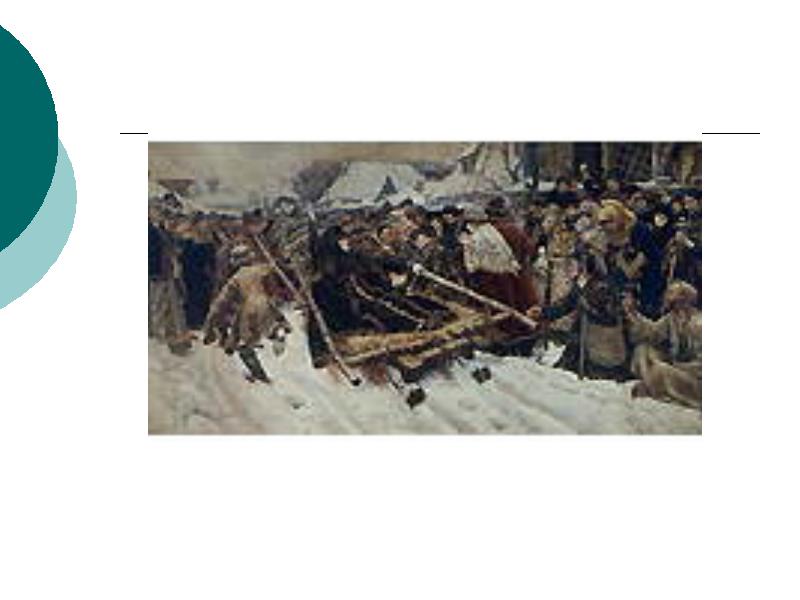
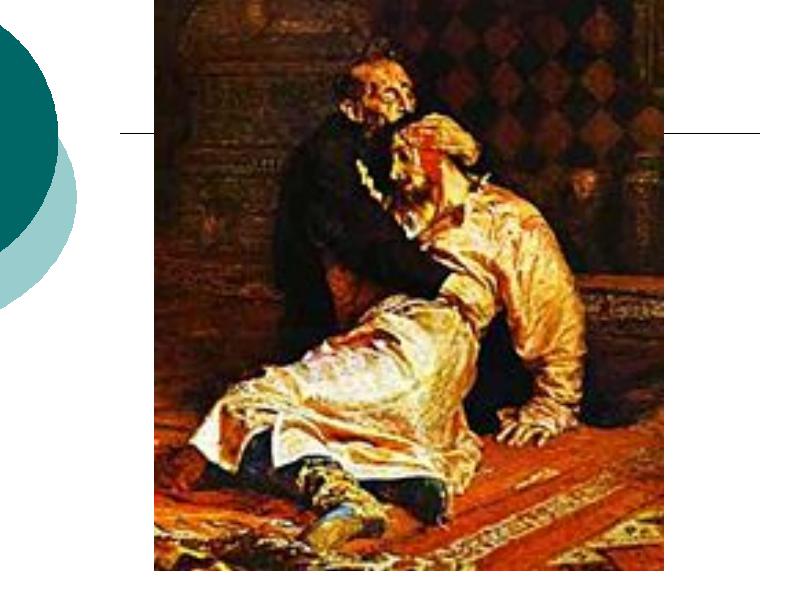
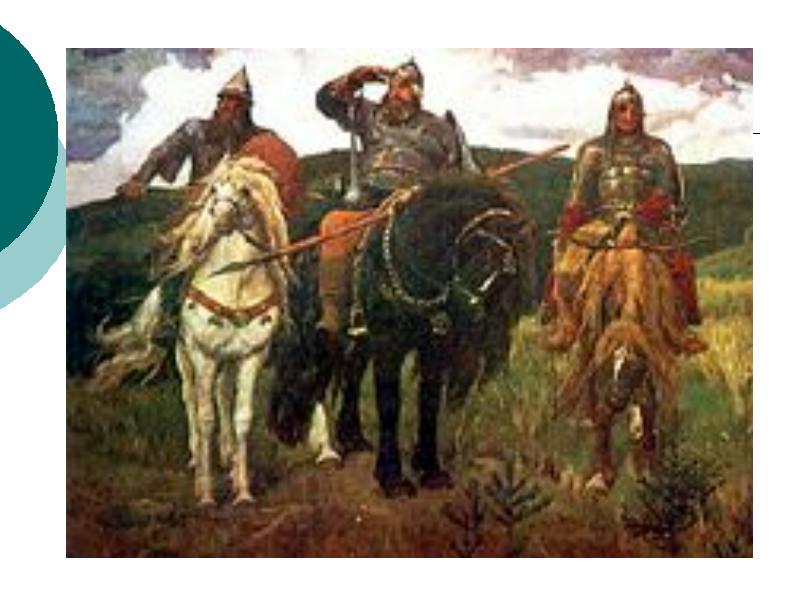
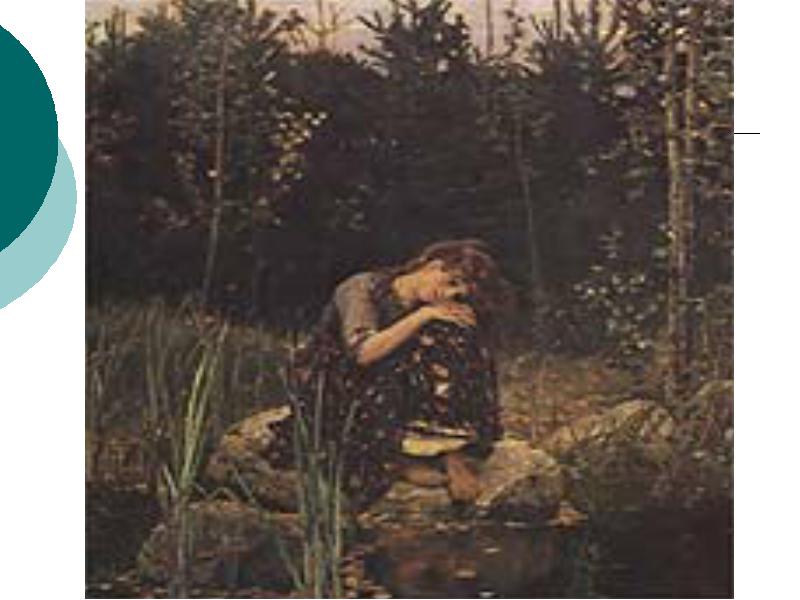
Seemingly scandalous exhibitions by A. Benois, K. Korovin, P. Konchalovsky willingly attend
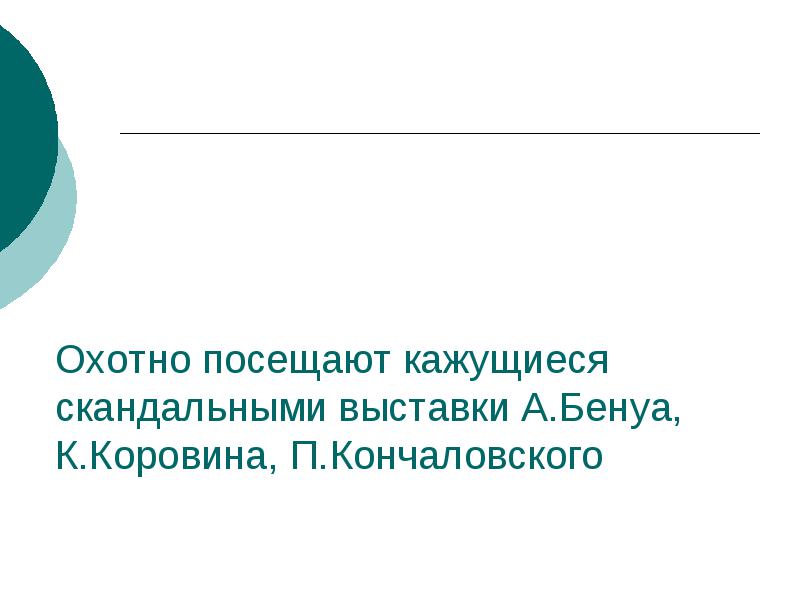
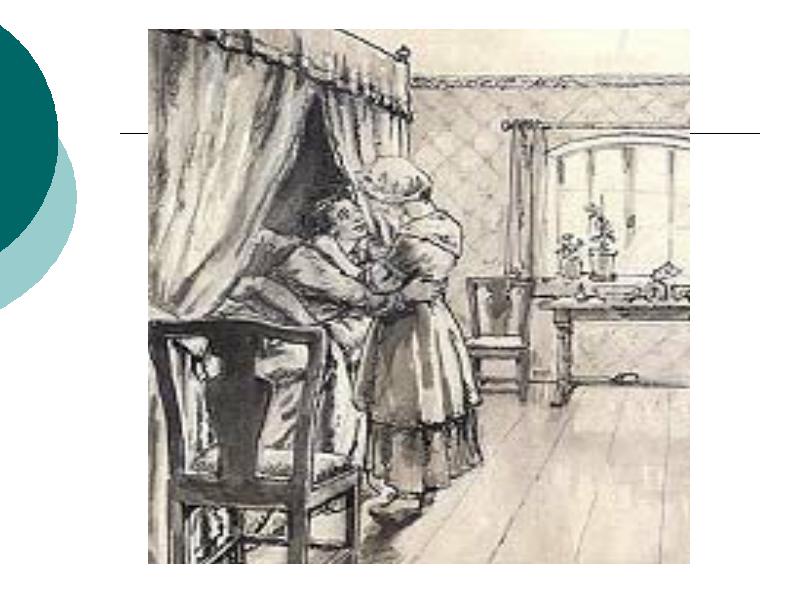
K. Korovin "Lanterns"
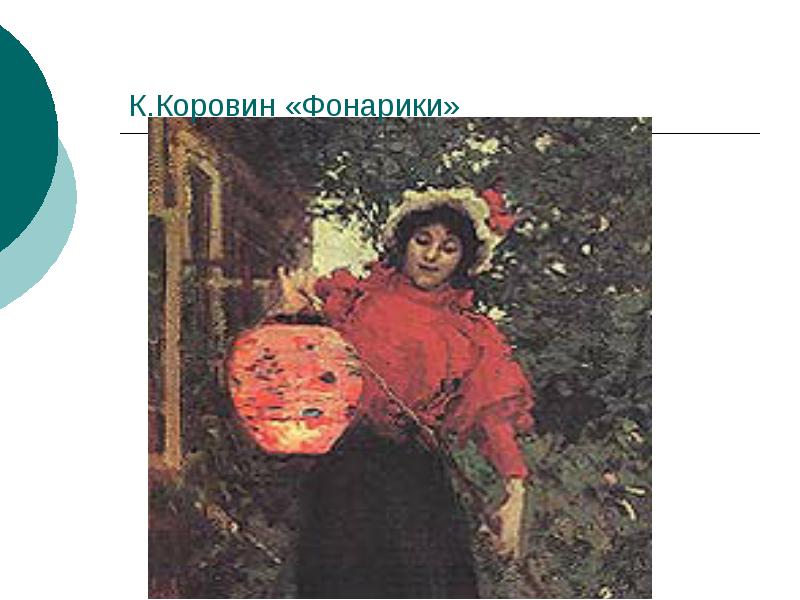
Composers continue to work in music:
Rimsky-Korsakov (operas The Tale of Tsar Saltan, The Golden Cockerel)
Stravinsky (ballet "Petrushka")
A.Glazunov
S.Rakhmaninov
A.Scriabin
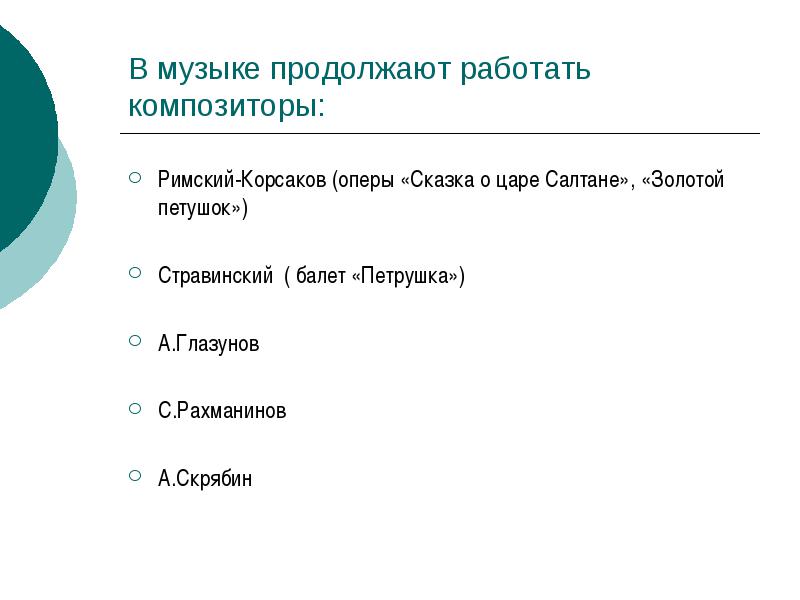
Russian realistic theater is flourishing
The system of K. Stanislavsky, who created the Moscow Art Theater, receives worldwide fame
The great theatrical reformers V. Meyerhold and E. Vakhtangov are working
Singer Fyodor Chaliapin shines
Ballet dancer Anna Pavlova
Vera Kholodnaya starred in the first silent films
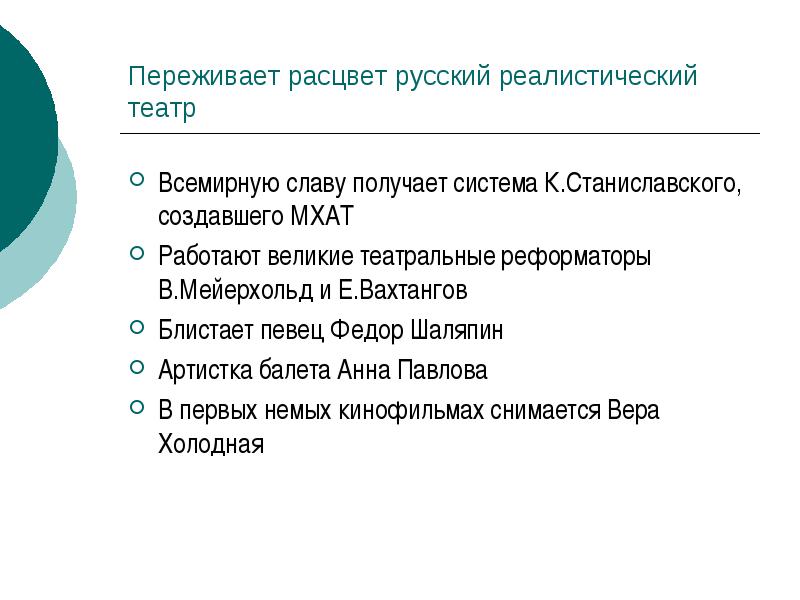
In Russian culture - SILVER AGE
Poets “are different from each other, from different clays. After all, these are all Russian poets, not for yesterday, not for today, but forever. God didn't hurt us like that."
O. Mandelstam
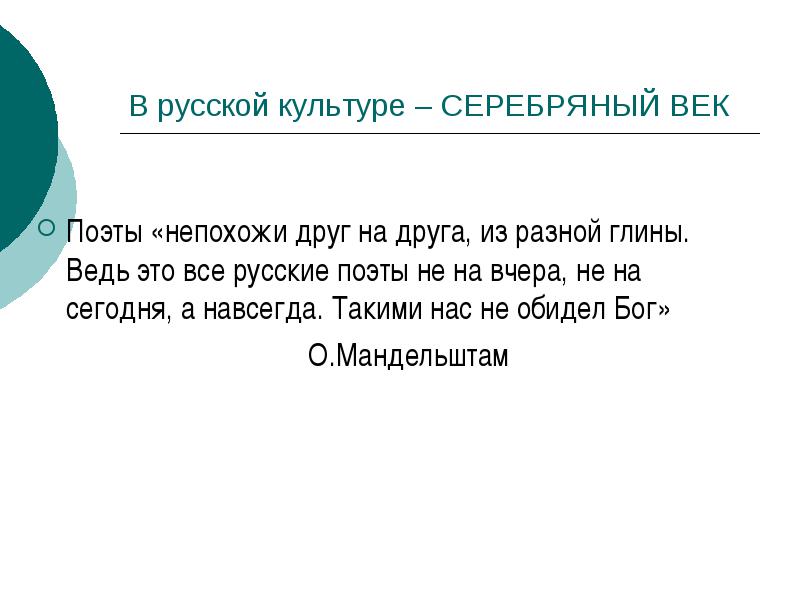
Literary movement and creative individuality are two key categories of the literary process of the early 20th century. Aesthetic thoughtlessness is a general trend in the lyrics of the SILVER AGE.

Characteristic figures standing outside the directions were M. Tsvetaeva, V. Khodasevich, M. Kuzmin
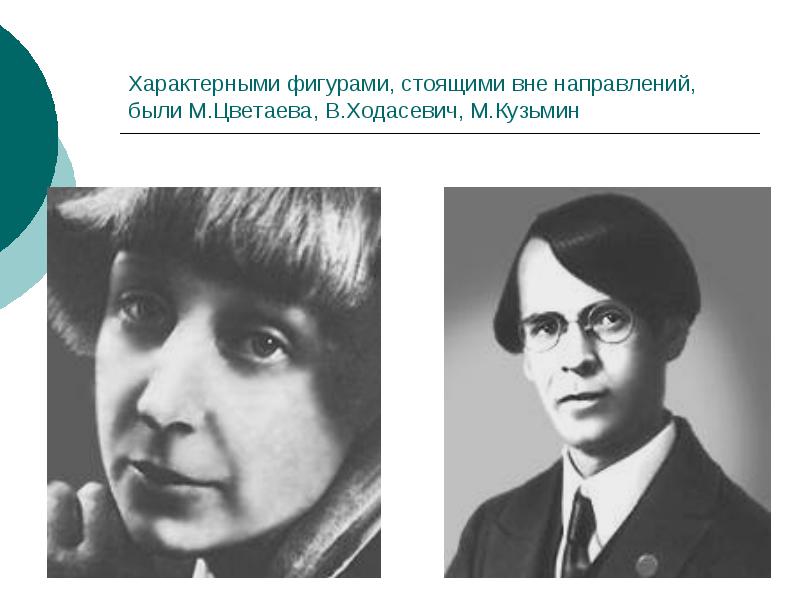
The desire to express more complex, volatile or contradictory states of the soul required a new attitude to the word-image.
I am a sudden break
I am the playing thunder
I am a clear stream
I am for everyone and no one
K. Balmont

There was a premonition of "coming rebellions"
Where are you, future Huns,
What cloud hung over the world?
I hear your cast-iron clatter
Through the still undiscovered Pamirs
V. Bryusov

The poems include exotic images and motifs as a counter to the measured philistine life
N. Gumilyov "Giraffe", "Lake Chad"
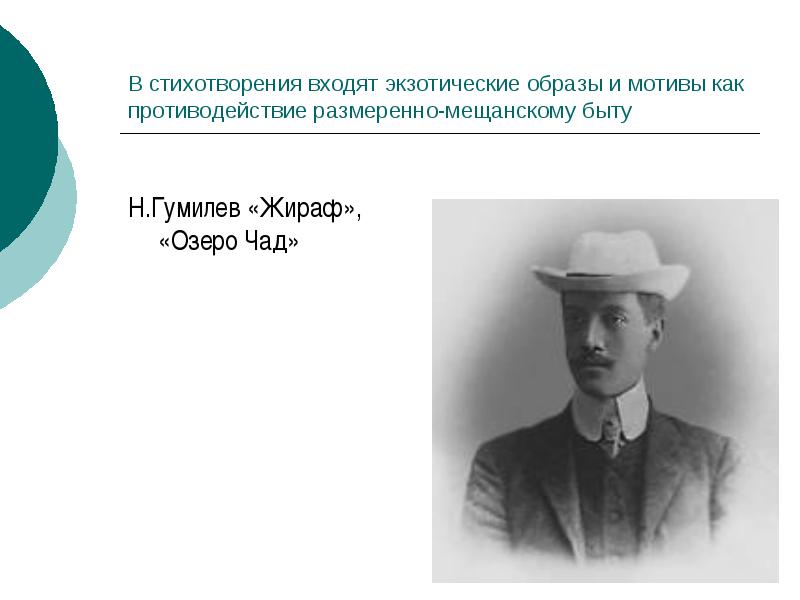
Poets-futurists proclaim a resolute "no" to the heritage of the classics, destroying the "aesthetics of junk" (verses by V. Mayakovsky, V. Khlebnikov)
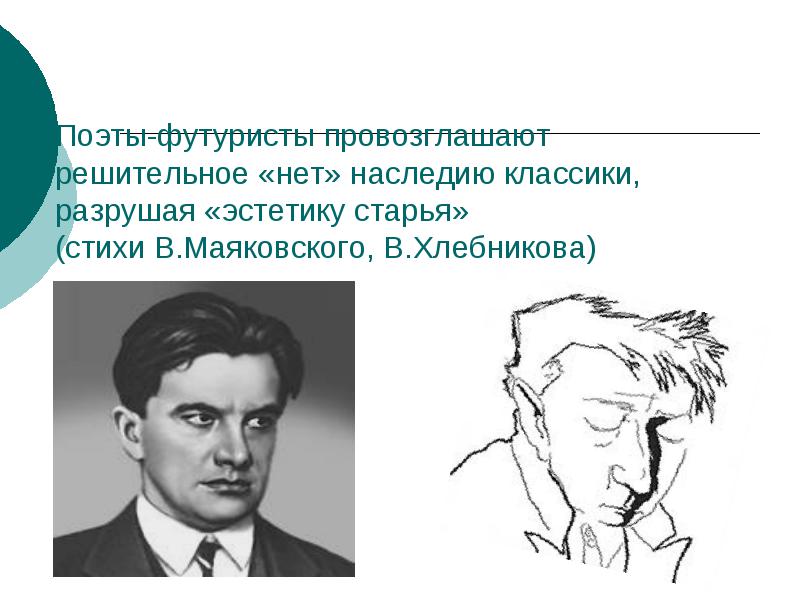
The New Age will truly be a century of spiritual renewal. Lots of people will die. But the earth will give birth to them even more, and - in the end - beauty, justice will overcome, the best aspirations of man will win. M. Gorky
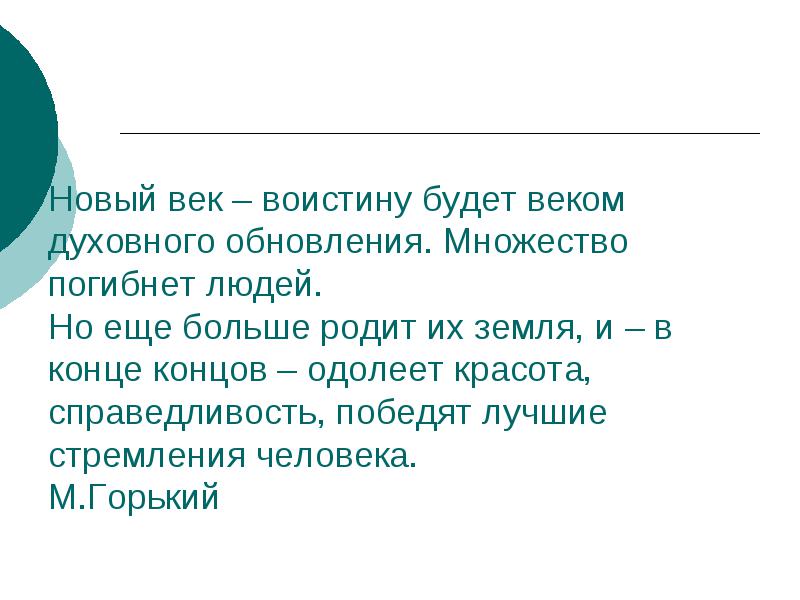
A writer, if only he is the Wave, and the ocean is Russia, Can't help but be outraged, When the elements are outraged. Ya. Polonsky

Lesson 1
INTRODUCTION CHARACTERISTICS OF THE LITERARY
PROCESS OF THE BEGINNING OF THE XX CENTURY. MANIFOLD
LITERARY TRENDS, STYLES, SCHOOLS, GROUPS.
Goals: to give an idea of the connection between the historical and literary processes of the beginning of the 20th century; to find out what is the originality of realism in Russian literature of the beginning of the century; note the diversity of literary trends, styles, schools, groups.
During the classes
Time is most interesting by the diversity of its contradictions and their abundance.
M. Gorky
I. Introductory talk.
Literature was offered for the summer for independent reading. Tell us about the books you read according to the plan:
1) What impression did the work make, what was especially memorable in it, why?
3) On what problem, with the reading and analysis of which chapter (episode, passage, poem) would you like to speak to the class?
Listen to the answers of 3-5 people.
Thus, a new era in literature began. With their problems, topics and authors. What is it, the twentieth century? Today's conversation will help to feel the atmosphere of the beginning of the 20th century.
A pre-prepared student reads A. Blok's poem by heart.
Nineteenth century, iron,
Truly a cruel age!
You in the darkness of the night, starless
Careless abandoned man!
In the night of speculative concepts,
materialistic small deeds,
Powerless complaints and curses,
bloodless souls and weak bodies!
With you came the plague to replace
Neurasthenia, boredom, spleen,
A century of smashing foreheads against the wall,
economic doctrines,
Congresses, banks, federations,
Table speeches, red words,
Age of stocks, rents and bonds
And inactive minds.
The twentieth century... Even more homeless
More scarier than life haze
(Even blacker and bigger
Shadow of Lucifer's wing).
Consciousness of a terrible deceit
All former small thoughts and faiths,
And the first airplane takeoff
Into the wilderness of unknown realms...
And disgusted with life
And crazy love for her
And passion and hatred for the motherland ...
And black, earthly blood
Promises us, inflating veins,
All destroying the frontiers,
Unheard of changes
Unforeseen riots...
II. Lecture.(The course of the lecture is outlined by the students.)
Man and the epoch is the main problem of art, since understanding the laws of development of the human personality is impossible without knowing the features of the historical situation in which this person exists. Therefore, at the beginning of the lecture, let us recall what our country was like in order to clarify the features of the Russian literary process.
1. Socio-economic and political development of Russia.
The beginning of the 20th century is the reign of Emperor Nicholas II, who ascended the throne in 1894. Russia at that time was a country with an average level of development of capitalism. The abolition of serfdom in 1861, the reforms of the 60–70s. did not pass without a trace: the capitalist industry grew at a high rate (first place in the world), new industries (oil, chemical, mechanical engineering) and new industrial regions (primarily Donbass-Krivoy Rog) arose.
Railways connected the Center with the outskirts and stimulated the development of the country.
Large banks connected with the industry arose.
The financial system after the reform carried out in 1897 by the Minister of Finance S.Yu. Witte (the introduction of gold backing of the ruble and the free exchange of paper money for gold) was one of the most stable in the world.
Russia is among the five most developed industrial countries.
But high quantitative indicators (growth rates, concentration level, production volumes) were combined with rather low qualitative ones. Labor productivity was low. The development of the economy was extremely uneven across sectors and regions of the country.
The agrarian question acquired extreme acuteness at the beginning of the 20th century. Historians call agriculture the Achilles' heel of Russia at that time.
Economic modernization began to have some impact on the social structure of the country. The nobility (1% of the population) remained a privileged, politically dominant class, but its economic situation gradually worsened.
The impoverishment of noble estates, described with sympathy by I. A. Bunin and A. P. Chekhov, was a remarkable phenomenon of the era.
The bourgeoisie, which was acquiring serious economic importance, was not united. A new Petersburg bourgeoisie grew up, closely connected with the state, banks and advanced industries.
The peasantry (more than 80% of the population) suffered from lack of land.
The position of the working class (less than 10% of the population) at the beginning of the 20th century was difficult. Long working hours, poor living conditions, low salary, lack of rights - these are the reasons that caused the discontent of the workers.
Officials, the clergy and the intelligentsia were special social groups.
By the beginning of the 20th century, modernization had practically not affected the political sphere. Russia remained an autocratic (absolute) monarchy.
2. Culture in Russia at the beginning of the 20th century.
Entering the 20th century, Russia was changing. Freedom of speech, press, assembly, and activities of political parties have become a reality. The revolution of 1905–1907 was a shock and a warning to society and the authorities.
There is nothing surprising in the fact that the beginning of the century brought Russia an extraordinary flowering of culture - heroic and tragic at the same time.
Significant changes took place in the education system. Seriously discussed the task of eliminating illiteracy, the introduction of universal primary education. The periodical press and book publishing played an important educational role.
The discoveries of Russian scientists were of world significance. I. Pavlov and I. Mechnikov became Nobel laureates.
In the artistic culture of the beginning of the 20th century, there is a riotous variety of styles, trends, ideas, and methods. The golden age of Russian culture, experienced in the 19th century, is replaced by its silver age, a new and whimsical flourishing.
The reading public is carried away by the romantic stories of M. Gorky and is shocked by his play "At the Bottom". I. Kuprin (“Duel”, “Garnet Bracelet”) and L. Andreev (“The Life of a Man”, “Tsar-Hunger”) are popular, I. Bunin is sad about the fate of the noble estates.
And in poetry, symbolist decadents (A. Blok, K. Balmont, V. Bryusov), acmeists (N. Gumilyov, A. Akhmatova), futurists (V. Mayakovsky, V. Khlebnikov) triumph. They criticize realism for sociality, naturalism, slavish adherence to reality and the desire to display it without transforming it.
Something similar happens in painting. They revere the realists I. Repin, V. Surikov, the Vasnetsov brothers, but willingly visit the seemingly scandalous exhibitions of the World of Art (A. Benois, K. Korovin) and the Jack of Diamonds (P. Konchalovsky, R. Falk).
N. Rimsky-Korsakov continues to work in music (the operas The Tale of Tsar Saltan, The Golden Cockerel), who taught A. Glazunov and I. Stravinsky (the ballet Petrushka). New artistic discoveries for Russia are the music of the young S. Rachmaninov and the experimental opuses of A. Scriabin.
The Russian realistic theater is flourishing. The system of K. Stanislavsky, who together with V. Nemirovich-Danchenko created the Moscow Art Theater, receives worldwide fame. The great theatrical reformers V. Meyerhold and E. Vakhtangov also come to the stage. Singer F. Chaliapin, ballet dancer A. Pavlova shine, Vera Kholodnaya and Ivan Mozzhukhin star in the first silent films.
The famous Russian Seasons (since 1907) are held in Paris, exhibitions of Russian painting, music and ballet are offered to sophisticated Parisians. Delight causes "The Dying Swan" performed by Anna Pavlova.
In Russian culture - silver Age.
3. The Silver Age of Russian Literature.
1) In parallel with the emergence of more and more new poetic schools, one of the most interesting trends of the era was growing stronger - the growth of the personal principle, the raising of the status of a creative individual in art.
Poets “are different from each other, from different clays. After all, these are all Russian poets, not for yesterday, not for today, but forever. God didn't hurt us like that." (O. Mandelstam).
2) Literary school (trend) and creative individuality are two key categories of the literary process of the early 20th century. Aesthetic thoughtfulness is a general trend in the lyrics of the Silver Age.
Characteristic figures standing outside the directions ("Lone Stars") were M. Tsvetaeva, M. Kuzmin, V. Khodasevich.
3) The development of capitalist relations leads to the emergence of the theme of the modern city ("Factory" by A. Blok, "Twilight" by V. Bryusov, "Tosca of the station" by I. Annensky, etc.).
4) The desire to express more complex, volatile or contradictory states of the soul required a new attitude to the word-image:
I am a sudden break
I am the playing thunder
I am a clear stream
I am for everyone and no one.
K. Balmont
There was a premonition of "coming rebellions":
Where are you, future Huns,
What cloud hung over the world?
I hear your cast-iron clatter
Through the still undiscovered Pamirs. V. Bryusov
5) The poems include exotic images and motifs as a counteraction to the measured bourgeois life (“Giraffe”, “Lake Chad” by N. Gumilyov).
6) Futurist poets proclaim a resolute “no” to the heritage of the classics, destroying the “aesthetics of junk” (verses by V. Mayakovsky, V. Khlebnikov, etc.)
III. Summary of the lesson.
- What did you get in the lesson to understand characteristic features literary process in Russia at the beginning of the 20th century?
1. Based on the lecture material, prepare a story on the topic “Socio-economic and cultural development Russia at the beginning of the 20th century.
2. Independent work with a textbook (by options):
Option I (pp. 8–14).
- What is the meaning of the definition "silver age"?
– How did N. Otsup distinguish between the “golden” and “silver” ages of Russian literature?
II option (pp. 15–19).
– What traditions of the classics have been adopted by the realistic prose of modern times?
- What are the features literary hero new era?
III option (p. 20–22).
What is the difference between modernism and realism?
– What brings together different currents of modernism?
IV option (p. 28–32).
– What are the features of the prose of the beginning of the century?
- What are the reasons for the emergence of various literary groups?
